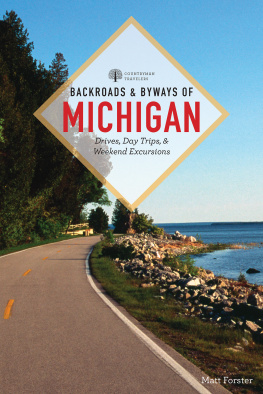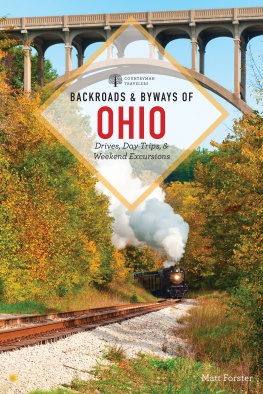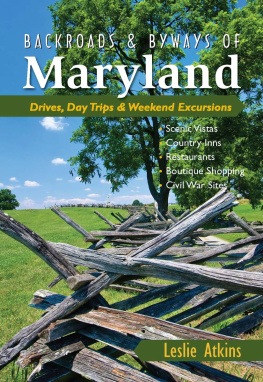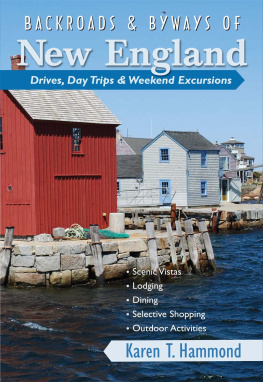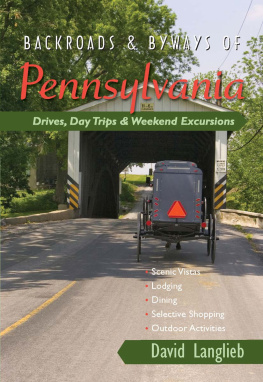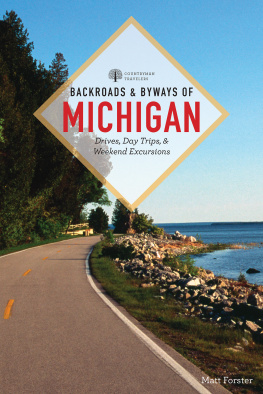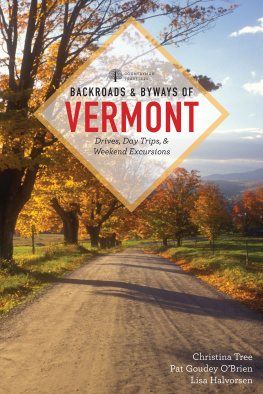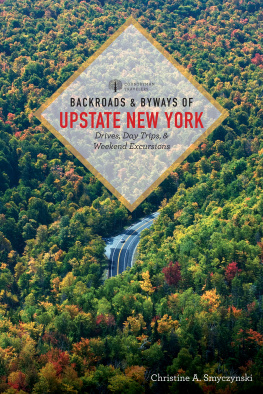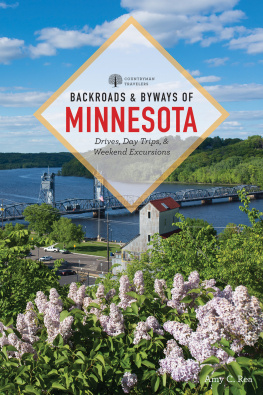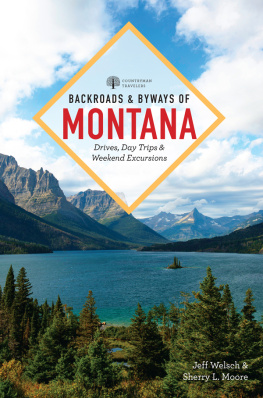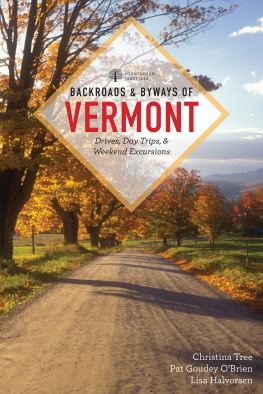
Other Books in the Backroads & Byw ays Series
Backroads & Byways o f Virginia
Backroads & Byways of Montana
Backroads & Byways of Georgia
Backroads & Byways of Upstat e New York
Backroads & Bywa ys of Utah
Backroads & Bywa ys of Ohio
Backroads & Byways of Alaska
Other Books from Ma tt Forster
Explorers Guid e Colorado
Backroads & Bywa ys of Ohio

Copyright 2018, 2014 and 2009 by The Countryman Press
Maps by The Countryman Press
All rights reserved
For information about permission to reproduce selections from this book, write to Permissions, The Countryman Press, 500 Fifth Avenue, New York, NY 10110
For information about special discounts for bulk purchases, please contact W. W. Norton Special Sales at specialsales@wwnorton.com or 800-233-4830
Cover design by Steve Attardo
Cover photograph Alex Jacque / Moment Open / Getty Images
The Countryman Press
www.countrymanpress.com
A division of W. W. Norton & Company, Inc.
500 Fifth Avenue, New York, NY 10110
www.wwnorton.com
978-1-58157-493-7 (pbk.)
978-1-58157-494-4 (e-book)
I sing a State of all the best,
Michigan, my Michigan.
I sing a State with riches blessed,
Michigan, my Michigan.
From Michigan, My Michigan,
the unofficial state song

Contents

THE VIEW OF DETROIT FROM BELLE ISLE PHOTO BY K IM FORSTER
Si quaeris peninsulam amoenam c ircumspice
(If you seek a pleasant peninsula, look about you)
Michigans state motto
M ichigan is best known for two things: the automobile industry and the Great Lakes. While making cars and trucks has traditionally driven the states economy, its the lakes that inspire visitors. Throughout the regions history, water has been the big attraction. Even the states natural resourceslumber, copper, and iron orewere all the more valuable because they could be transported by water.
Michiganders live with the understanding that they are at all times surrounded by water on three sides. In fact, no matter where you are in the state, you are never farther than 85 miles from a Great Lake. And while millions of travelers make their way here to lay out on Lake Michigans sandy beaches or see Superiors Picture Rocks, they also come for the 11,000 inland lakes and to enjoy fishing, paddling, and swimming on 36,000 miles of rivers and streams.
All of the states large urban centers are found in the southern half of the Lower Peninsula. North of Flint, the only interstate is I-75, which makes a beeline north for the Mackinac Bridge and then northeast to Sault Ste. Marie. Michigan is the largest state east of the Mississippi, and with most of the population concentrated in the south, this leaves much of the states 58,000 square miles inaccessible by the interstate highway system. It turns out then that backroads and byways are the best way to explore Michigan. With a few exceptions, travelers who stick close to the multilane highways will miss out on nearly all the beauty and adventure Michigan has to offer.
This guide is the result of a lifetime of exploring the state. I like to get off the highway and seek alternate routes. If the highway is the shortcut, I am inclined to find the long cut. Over the years, I am still surprised at the number of charming small towns and villages that lie right off the beaten path. Even in the cities, there is so much off the beaten path that is missed by the day-to-day commuters.

THE ROUND ISLAND LIGHTHOUSE GREETS VISITORS TO MACKINAC ISLAND
Each of these towns tells a story about a different time in Michigans history. Interestingly, the first Europeans to find their way into the Great Lakes did not linger in the Lower Peninsula; the French missionaries and trappers made their way to Native American settlements farther north. The land was home to several Native American tribes, like the Ojibwa and the Menominee, who used the waterways as transportation and fished the areas rivers. One of the regions most important meeting places was near Sault Ste. Marie, where fish were plentiful on the St. Marys River.
Missionaries set up small chapels, and trappers took advantage of the meeting places for trading furs for goods and supplies. The fur trade soon became a significant industry, and trappers traded their furs at the Sault or near the Straits of Mackinac before heading back into the wilderness. Their furs were shipped eventually to Europe, beginning their journey on the St. Lawrence Seaway.
Later, lumber and mining would become the main drivers of the regions economy. When the Upper Peninsulas vast mineral resources were discovered in the early 1800s, mining was begun, and immigrants soon arrived to tackle the difficult job of getting iron ore and copper to the surface. They came from all over Europe, but primarily from Norway, Finland, Italy, and England. They and their descendants have profoundly shaped the Upper Peninsulas unique culture. It is said that the pasties (meat pies) you find at every restaurant were brought over by English miners from Cornwall.
The Upper Peninsula (U.P.) is unlike any place youve visited before. Some have said that anywhere you go in the U.P. is off the beaten path. Thats true. This region is known for its rugged wilderness and natural beauty. Surrounded by three of the largest freshwater lakes in the world, the U.P. hosts two mountain ranges, more than 150 waterfalls, and 4,300 inland lakes. It is custom-made for hiking, biking, paddling, and fishing.
Cities in the Lower Peninsula took advantage of the states natural resources. Early on, Michigans lumber was being used to make furniture in Grand Rapids. The industry grew to the point that it was known as Furniture City, the furniture-making capital of the world. Although the material is different, Steelcase continues the industrys legacy with the manufacturing of heavy-duty office furniture.
In 1903, a Detroit inventor named Henry Ford incorporated the Ford Motor Company. By 1908, his little outfit was producing Model Ts, soon at a pace that revolutionized industry. The automobile industry attracted thousands of laborers from around the country. Many came up from the South, which was still struggling to transition from an economy based on agriculture to one based on industry. By 1914 Ford was paying factory workers five dollars a day, and there was plenty of work for all. The role of the auto industry in the growth and development of Detroit cannot be underestimated.
By the 1960s Detroit fell on hard times. The first blow was essentially cosmetic. Once known for its hundreds of thousands of stately elm trees, Dutch elm disease first hit Detroit in the 50s. By the 70s the elms were all but completely decimated. The biggest change, however, came in 1967, when racial tensions were at an all-time high. The Detroit Riots lasted five days and seemed to spur wealthier white residents to move to the suburbs. The city is still trying to recover from the effects of this demographic change. In fact, its not hard to see how the loss of population led to the citys decision to declare bankruptcy in 2013.
Next page
